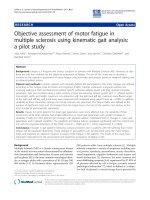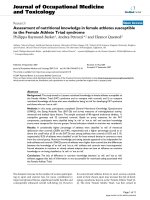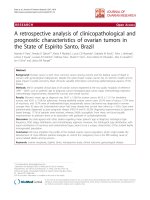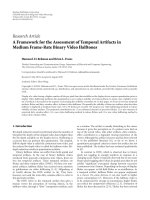Assessment of surgical treatment of wilms tumors in children according to siop 2001
Bạn đang xem bản rút gọn của tài liệu. Xem và tải ngay bản đầy đủ của tài liệu tại đây (448.1 KB, 7 trang )
Assessment of surgical treatment
Bệnh viện
of Trung
wilmsương
tumors...
Huế
ASSESSMENT OF SURGICAL TREATMENT OF WILMS TUMORS IN
CHILDREN ACCORDING TO SIOP 2001
Dang Huu Chien1, Truong Dinh Khai 2
SUMMARY
Objective: To assess the results of surgical treatment of Wilms tumors in children according to SIOP 2001.
Study method: A descriptive and retrospective study of cases diagnosed of Wilms tumors by age, according to Algorithm of Diagnosis and Treatment of Wilms Tumors (SIOP 2001).
RESULTS: There were 47 pediatric patients of nephroblastoma treated in accordance with SIOP 2001
algorithm who had survival rate, no relapse for 1 year of 82.9%. The overall survival rate was 91.5%. Accidents during surgery include tumor ruptures (8.51%), injuries to colon and jejunum (8.51%) and lacerations
of inferior vena cava (4.26%).
Conclusion: The results of surgical treatment of nephroblastoma in accordance of the SIOP 2001 algorithm are relatively good despite the fact that the follow-up is short-term and small in numbers to compare
with other research groups in the world.
Key words: Wilms tumor or nephroblastoma, surgical treatment, SIOP 2001 algorithm.
I. INTRODUCTION
Wilms tumor or nephroblastoma is the most
common type of cancer that accounts for 95% of
all kidney tumors in children [10]. Nearly 1,000
children are diagnosed of having Wilms tumors
each year in Europe. The Wilms tumors are mostly
diagnosed in the age of 2 to 4 years, in one kidney
and large in size. The survival rate without relapse
after 5 years for the patients with tumors treated
in the localized stage was 91% in the 2004 SIOP
study [10].
II. STUDY METHOD
Descriptive and retrospective study was
performed in a series of cases treated from June
2013 to June 2017 at Children’s Hospital 2. We
enrolled 62 pediatric patients with kidney tumors
1. Pediatric Hospital Gia Lai
2. Medicine and Pharmacy of University at HCM City
32
in the study sample of 2001 SIOP. Wilms tumors
are diagnosed in 47 cases (76%) and other tumors
diagnosed in the rest.
III. RESULTS AND DISCUSSIONS
3.1. Wilms tumors and other kidney tumors
Chart 1. Prevalence of Wilms tumors and other
kidney tumors
Prevalence
The prevalence of Wilms tumors is high, up to
two-thirds of all kidney tumors
- Received: 8/8/2018; Revised: 16/8/2018
- Accepted: 27/8/2018
- Corresponding author: Dang Huu chien
- Email: , Tel: 0914009090
Journal of Clinical Medicine - No. 51/2018
Hue Central Hospital
Table 1. Percentage of kidney tumors in the study sample
Percentage of kidney tumors
Tumor types
Prevalence
Percentage %
Wilms tumor
Congenital Mesoblastic nephroma
Kidney epithelial cell cancers
Clear cell sarcoma
Rhabdoid tumor
Renal cell carcinoma
Cystic renal tumor
Neuroblastoma
47
4
3
2
2
2
1
1
75.8
6.5
4.9
3.2
3.2
3.2
1.6
1.6
Total
62
100
3.2. Age and Gender
The mean age of the study sample was less
than 5 years (26.9 ± 25.9), ranged 1-80 months.
The age of males was lower than that of females,
but the difference was not statistically significant
(p = 0.52). The cases in each age group are unevenly
distributed, mostly in the age group of 6 months to 5
years old (38/47, 80.85%).
- In the study, Wilms tumors were found in female
infants more than in male (female / male = 1:1.14).
This result is similar to that of 1: 11 of Nguyen Huu
Dung [1]; 1: 1.22 of North American studies [10] and
1: 1 of SIOP study in Europe [10].
3.3. Genetic syndromes
Most of cases have no accompanying congenital
abnormalities. There is a case of absence of iris and a
case of hemihypertrophy disorder.
All cases have normal family history.
3.4. Ultrasound, CT scans and MRI
+ Ultrasound
In 62 cases of renal tumors, ultrasonography accurately identified 59 cases (95%) and diagnosed
incorrectly 3 cases (5%). Doppler ultrasound is a
good tool to investigate invasion to renal veins and
inferior vena cava, with sensitivity and specificity
comparable to CT and MRI [6], [7], [3]. However, in
our study, we did not collect sufficient information to
evaluate the role of Doppler ultrasound.
+ CT scans, MRI
In Table 1, 15/62 cases (24.2%) of other cancers
were diagnosed as nephroblastoma on imaging
studies and received chemotherapy before surgical
treatment. According to SIOP, a falsely positive
diagnosis is of 5% [10]. However, this 5% rate does
not include other kidney cancer cases such as clear
cell renal sarcoma renal artery sarcoma, rhabdoid
renal tumor. These cancers have a significantly worse
prognosis and require postoperative treatments
different from nephroblastoma. The UK and
Germany studies, members of the SIOP, showed that
the incidence of pathology of nephroblastoma was
12% and 7.8%, respectively.
The relevance of diagnostic imaging studies
to pathological results in our study is lower than
that of SIOP. This difference may result from the
nephroblastoma incidence of 75.8% in Children’s
Hospital 2, lower than that of SIOP, 85-90%. The
incidence of clear cell sarcoma, rhabdoid renal
tumor, which are very difficult to distinguish from
nephroblastoma imaging studies, in our study are
much higher than that of SIOP.
3.5. Locations of Wilms tumors
In our study, Wilms tumors were found in right,
left and bilateral kidneys of 45.2%, 48.4% and 6.4%,
respectively.
Most studies in Vietnam and abroad show no
differences in the location of Wilms tumor in the
right or left kidneys [1], [3]. According to Nevillet
Journal of Clinical Medicine - No. 51/2018
33
Assessment of surgical treatment
Bệnh viện
of Trung
wilmsương
tumors...
Huế
and Arif N. Ali [4], Wilms tumors in bilateral kidneys the tumors were so big and compressed the renal
account for about 4-7%. Tran Duc Hau shows the parenchyma that we could not identify their original
rate of 5.4% in bilateral kidneys [2] in Vietnam. locations. There were regional lymphadenopathy in
These incidences are in line with our findings. A 4 cases. The lymph nodes were smaller than 1.2 cm,
number of studies in the world have shown higher possibly inflammatory lymph nodes.
incidences of nephroblastoma in bilateral kidneys
The literature also describes cases in which Wilms
in children acquiring congenital malformations tumors originated out of the kidneys, but rare [10]. In
such as WAGR, Beckwith-Wiedemann syndrome our study, no cases of extrarenal Wilms tumors were
and hemihypertrophy. However, 85% of pediatric found.
patients children with WAGR or Beckwith3.6. Distant metastasis
Wiedemann syndrome have a unilateral kidney
In our study, there were 3 cases of metastases (1
tumor.
case of pulmonary metastasis, 1 case of liver metastaIn our study, the intrarenal location of Wilms sis, 1 case of peritoneal metastasis). Metastatic rates
tumors were found in upper pole as 34%, lower pole of 6.4% are similar to those of Abd El-Aal [4] but are
38%, and middle of the kidney 15%. In 6 cases (13%), lower than those of Breslow [5].
Table 2. Comparison of rates of metastasis
Studies
Cases
Distant metastasis
Rate (%)
62
4
6.5
Breslow [5]
1991
236
11.8
Our study
47
3
6.4
Abd El-Aal [4]
I n three cases of distal metastasis demonstrated on imaging studies, our hospital was not eligible for biopsy and cell-specific identification of distant metastatic lesions. This is a limitation of our study, but after
chemotherapy, all of these lesions have disappeared and this indicates that distant metastatic lesions are
potentially sensitive to chemotherapy.
3.7. Stages
Table 3. Distribution of stages of disease and preoperative chemotherapy
Preoperative chemotherapy
Stages
I
II
III
IV
V
Total
Yes
No
Total
8
23.53%
19
55.89%
3
8.82%
1
2.94%
4
11.76%
35
100%
5
38.5%
5
38.5%
1
17.69%
1
2.94%
0
0%
12
100%
13
27.66%
24
51.06%
4
8.51%
2
4.26%
4
8.51%
47
100%
Note: The above row is the case number, the bottom row is the percentage.
34
Journal of Clinical Medicine - No. 51/2018
Hue Central Hospital
Stage II accounts for the largest number when considering two groups of surgery with and without
preoperative chemotherapy, including 9 cases in the age group considered for surgery without preoperative
chemotherapy and 3 cases in the group from 6 months to 60 months without imaging studies suggesting
Wilms tumors.
3.8. Classification of risk groups according to pathology
Table 4. Risk distribution by pathology
Risk
Low
Medium
High
Tổng
Preoperative chemotherapy
Yes
No
5
14.7%
25
73.5%
4
11.6%
34
1
7.69%
11
84.6%
2
15.4%
13
100%
100%
Note: The above row is the case number, the bottom row is the percentage.
Rates %
6
12.8%
35
74.5%
6
12.8%
47
100%
The risk for Wilms tumors is mainly focused on stage II, with moderate risk. This result is consistent
with other SIOP studies.
3.9. Surgical complications in groups of surgery with and without chemotherapy
Table 5. Rates of complications in groups of surgery with and without chemotherapy
With preoperaWithout preoperative
Complications
tive chemotherapy
Total
chemotherapy (n=13)
(n=34)
1/34
3/13
4/47
Intraoperative tumor rupture
(2.94%)
(23.07%)
(8.51%)
Surrounding organ removal
1/34
(2.94%)
2/13
(15.38%)
3/47
(6.38%)
Inferior vena cava laceration
0/34
(0%)
2/13
(15.38%)
2/47
(4.26%)
0/34
(0%)
1/13
(7.69%)
1/47
(2.13%)
2/34
(5.89%)
8/13
(61.5%)
10/47
(21.3%)
Surrounding organ damage
Total
The complication rates of the surgical group without preoperative chemotherapy (61.5%) was 10 times
higher than the surgical group with preoperative chemotherapy (5.89%). The common complication during
surgery is tumor rupture. This indicates the effectiveness of preoperative chemotherapy in reducing surgical
complications, including tumor rupture, resulting in reduction of stage III tumors. According to Ehrlich PF
(2016) and colleagues, the rates of intraoperative complications is quite high, affecting the survival rate of
pediatric patients (14.28%) [8]
Journal of Clinical Medicine - No. 51/2018
35
Assessment of surgical treatment
Bệnh viện
of Trung
wilmsương
tumors...
Huế
3.10. Perirenal fat invasion
Table 6. Perirenal fat invasion
Perirenal fat invasion
Cases
Rates %
Yes
5
11.7
No
42
89.3
Total
47
100
Preoperative chemotherapy improves local factors in reducing the incidence of tumor ruptures and
avoiding tumor cells left. Investigation of perirenal fat invasion is important in Wilms tumor staging. Once
the tumors invade through the renal capsules, stage III will be established.
3.11. Intratumoral hemorrage
Table 7. Rates of intratumoral hemorrage
Intratumoral hemorrage
Cases
Rates %
Yes
35
74.5
No
12
25.5
Total
47
100
Wilms tumors have intratumoral haemorrhage rates as high as 74.5%. Surgery should be carried out
carefully and gently to avoid intraoperative tumor rupture.
3.12. Tumor volumes
Table 8. Comparison of tumor volumes before chemotherapy and surgery
Wilms tumor volumes (cm3)
Cases
Before chemotherapy
Before surgery
27
47
P
Mean
Median
Smallest
Largest
554.6 ± 531.8
435.7
25.2
2836.2
380.3 ± 518.0
255.4
2.8
2757.0
<0.001*
(* : Fisher test)
The median value of tumor volume after chemotherapy was smaller than that before chemotherapy and
the difference was statistically significant, with p <0.001. This is comparable to Tran Duc Hau’s study[2]
and 2001 SIOP [9]. This shows the effect of preoperative chemotherapy in reducing tumor volume.
3.13. Treatment results
Until 30/06/2017, the follow-up of 47 patients
(34 cases with preoperative chemotherapy, 13 cases
without preoperative chemotherapy) is presented as
follows:
- 39 patients were healthy, event-free survival no
disease (82.9%).
36
- 43 living patients (91.5%) and 4 patients died
(8.51%).
- 8 patients with complications (17.02%). Of
which there were 2 cases of relapse (4.25%), 3 patients with distant metastasis (6.38%), 2 patients
suffering toxic effects of chemotherapy (4.25%)
and 1 patient abandoned treatment (2.13%).
Journal of Clinical Medicine - No. 51/2018
Fig. 1
Hue Central Hospital
Tumor volumes before (V=191 ml) and after (V=63 ml) preoperative chemotherapy
“ Source: Rơ Châm H. SHS 15043499”
Table 9. Comparison of survival rates in developed countries
Survival rates (%)
Our study
(n=47)
SIOP 2001
(n=3686)
NWTS-4
(n=3335)
UK
(n=714)
1 year - survival rate, event-free
82.9 %
1 year – survival rate, overall
91.4 %
5 year – survival rate, event-free
87 %
86 %
77.2 %
5 year – survival rate, overall
93 %
93,7 %
87.5 %
The estimated 1-year survival rates, event-free and overall, of our study were lower than those of the
SIOP and NWTSG study groups, and higher than that of patients treated with SIOP algorithm in UK. These
differences may come from the fact that our study is small in numbers of patients and short time in followup, leading to difficult for comparison. However our survival rate reached approximately 80-90% reflects
good therapeutic efficacy of the regimen.
IV. CONCLUSIONS
The treatment results of nephroblastoma in accordance with 2001 SIOP regimen are relatively
good. Healthy survival rate, event-free in a year
is 82.9%; the overall survival rate was 91.5%.
Two important factors that have prognostic value
are the disease stage and the risk groups of pathology.
REFERENCES
1. Nguyễn Hữu Dũng (2000), “Bướu Wilms trẻ em:
dịch tễ học, chẩn đoán và điều trị”, Luận văn
thạc sĩ Y học, Đại học Y Dược TP. Hồ Chí Minh.
2. Trần Đức Hậu (2013). “Nghiên cứu kết quả điều
trị u nguyên bào thận theo phác đồ SIOP 2001
tại Bệnh viện Nhi Trung ương”. Tạp chí nhi
khoa, tr.54-59.
3. Đào Thị Thùy Trang (2013). “Đặc điểm hình ảnh
cắt lớp vi tính u nguyên bào thận trẻ em”. Tạp
chí Y học Thành phố Hồ Chí Minh.
4. Abd El-Aal HH, Habib EE, Mishrif MM, (2005),
“Wilms’ tumor: the experience of the pediatric
unit of Kasr El-Aini center of radiation oncology
and nuclear medicine (NEMROCK)”. J Egypt
Natl Canc Inst, 17(4): pp. 308-314.
Journal of Clinical Medicine - No. 51/2018
37
Bệnh viện Trung ương Huế
Assessment of surgical treatment of wilms tumors...
5. Breslow NE, Churchill G, Nesmith B, et al.
(1986), “Clinicopathologic features and prognosis for Wilms’ tumor patients with metastases at
diagnosis”. Cancer, 58(11): p. 2501-11.
6. Brisse HJ, Smeths AM, Kaste SC, et al. (2008),
“Imaging in unilateral Wilms tumour”, Pediatr
Radiol, 38(1): pp. 18-29.
7. Chung EM, Grant E, Conran MR, et al. (2016),
“Renal Tumors of Childhood: Radiologic-Pathologic Correlation Part 1. The 1st Decade: From
the Radiologic Pathology Archives”. RadioGraphics, 36(2): pp. 499-522.
8. Ehrlich PF, Ritchey ML, Hamilton TE et al.
38
(2016), “Surgical protocol violations in children with renal tumors provides an opportunity
to improve pediatric cancer care: a report from
the Children’s Oncology Group”. Pediatr Blood
Cancer, 63(11). pp. 1905-10.
9. Niedzielski J, Taran K, Mlynarski W, et al.
(2012), “Is the SIOP-2001 Classification of Renal Tumors of Childhood accurate with regard to
prognosis? A problem revisited”. Arch Med Sci,
8(4): pp. 684-9.
10. Pizzo AP, Poplack DG, (2015), “ Renal tumors”,
In: Principles and practice of pediatric oncology, Wolters Kluwer, ed 7th , pp. 875-95
Journal of Clinical Medicine - No. 51/2018









